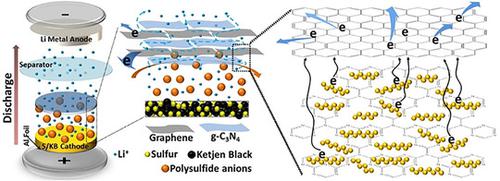当前位置:
X-MOL 学术
›
ChemSusChem
›
论文详情
Our official English website, www.x-mol.net, welcomes your
feedback! (Note: you will need to create a separate account there.)
Enhanced Cycling Performance for Lithium–Sulfur Batteries by a Laminated 2D g‐C3N4/Graphene Cathode Interlayer
ChemSusChem ( IF 7.5 ) Pub Date : 2018-11-28 , DOI: 10.1002/cssc.201802449 Long Qu 1, 2 , Pei Liu 1 , Yikun Yi 1 , Tao Wang 3 , Pu Yang 1 , Xiaolu Tian 1 , Mingtao Li 1 , Bolun Yang 1 , Sheng Dai 4
ChemSusChem ( IF 7.5 ) Pub Date : 2018-11-28 , DOI: 10.1002/cssc.201802449 Long Qu 1, 2 , Pei Liu 1 , Yikun Yi 1 , Tao Wang 3 , Pu Yang 1 , Xiaolu Tian 1 , Mingtao Li 1 , Bolun Yang 1 , Sheng Dai 4
Affiliation

|
Decay in electrochemical performance resulting from the “shuttle effect” of dissolved lithium polysulfides is one of the biggest obstacles for the realization of practical applications of lithium–sulfur (Li–S) batteries. To meet this challenge, a 2D g‐C3N4/graphene sheet composite (g‐C3N4/GS) was fabricated as an interlayer for a sulfur/carbon (S/KB) cathode. It forms a laminated structure of channels to trap polysulfides by physical and chemical interactions. The thin g‐C3N4/GS interlayer significantly suppresses diffusion of the dissolved polysulfide species (Li2Sx; 2<x≤8) from the cathode to the anode, as proven by using an H‐type glass cell divided by a g‐C3N4/GS‐coated separator. The S/KB cathode with the g‐C3N4/GS interlayer (S/KB@C3N4/GS) delivers a discharge capacity of 1191.7 mAh g−1 at 0.1 C after 100 cycles, an increase of more than 90 % compared with an S/KB cathode alone (625.8 mAh g−1). The S/KB@C3N4/GS cathode shows good cycling life, delivering a discharge capacity as high as 612.4 mAh g−1 for 1 C after 1000 cycles. According to XPS results, the anchoring of the g‐C3N4/GS interlayer to Li2Sx can be attributed to a coefficient chemical binding effect of g‐C3N4 and graphene on long‐chain polysulfides. Generally, the improvement in electrochemical performance originates from a coefficient of the enhanced Li+ diffusion coefficient, increased charge transfer, and the weakening of the shuttle effect of the dissolved Li2Sx as a result of the g‐C3N4/GS interlayer.
中文翻译:

层压的2D g-C3N4 /石墨烯阴极夹层增强了锂硫电池的循环性能
溶解的多硫化锂的“穿梭效应”导致的电化学性能下降是实现锂硫(Li-S)电池实际应用的最大障碍之一。为了应对这一挑战,制造了2D g-C 3 N 4 /石墨烯片复合材料(g-C 3 N 4 / GS)作为硫/碳(S / KB)阴极的中间层。它形成通道的叠层结构,通过物理和化学相互作用捕获多硫化物。薄的g‐C 3 N 4 / GS中间层显着抑制了溶解的多硫化物种类的扩散(Li 2 S x ; 2 < x≤8)从阴极到阳极,这是通过使用H型玻璃电解槽除以agC 3 N 4 / GS涂层隔离膜来证明的。具有g‐C 3 N 4 / GS中间层(S / KB @ C 3 N 4 / GS)的S / KB阴极在100个循环后在0.1 C下的放电容量为1191.7 mAh g -1,增加了超过与单独的S / KB阴极(625.8 mAh g -1)相比,为90%。S / KB @ C 3 N 4 / GS阴极显示出良好的循环寿命,经过1000次循环后,在1 C下的放电容量高达612.4 mAh g -1。根据XPS结果,g‐C 3 N的锚固Li 2 S x的4 / GS中间层可归因于g-C 3 N 4和石墨烯对长链多硫化物的化学结合系数。通常,电化学性能的改善源自于增加的Li +扩散系数,增加的电荷转移以及由于g‐C 3 N 4 / GS导致的溶解的Li 2 S x的穿梭效应减弱。中间层。
更新日期:2018-11-28
中文翻译:

层压的2D g-C3N4 /石墨烯阴极夹层增强了锂硫电池的循环性能
溶解的多硫化锂的“穿梭效应”导致的电化学性能下降是实现锂硫(Li-S)电池实际应用的最大障碍之一。为了应对这一挑战,制造了2D g-C 3 N 4 /石墨烯片复合材料(g-C 3 N 4 / GS)作为硫/碳(S / KB)阴极的中间层。它形成通道的叠层结构,通过物理和化学相互作用捕获多硫化物。薄的g‐C 3 N 4 / GS中间层显着抑制了溶解的多硫化物种类的扩散(Li 2 S x ; 2 < x≤8)从阴极到阳极,这是通过使用H型玻璃电解槽除以agC 3 N 4 / GS涂层隔离膜来证明的。具有g‐C 3 N 4 / GS中间层(S / KB @ C 3 N 4 / GS)的S / KB阴极在100个循环后在0.1 C下的放电容量为1191.7 mAh g -1,增加了超过与单独的S / KB阴极(625.8 mAh g -1)相比,为90%。S / KB @ C 3 N 4 / GS阴极显示出良好的循环寿命,经过1000次循环后,在1 C下的放电容量高达612.4 mAh g -1。根据XPS结果,g‐C 3 N的锚固Li 2 S x的4 / GS中间层可归因于g-C 3 N 4和石墨烯对长链多硫化物的化学结合系数。通常,电化学性能的改善源自于增加的Li +扩散系数,增加的电荷转移以及由于g‐C 3 N 4 / GS导致的溶解的Li 2 S x的穿梭效应减弱。中间层。











































 京公网安备 11010802027423号
京公网安备 11010802027423号